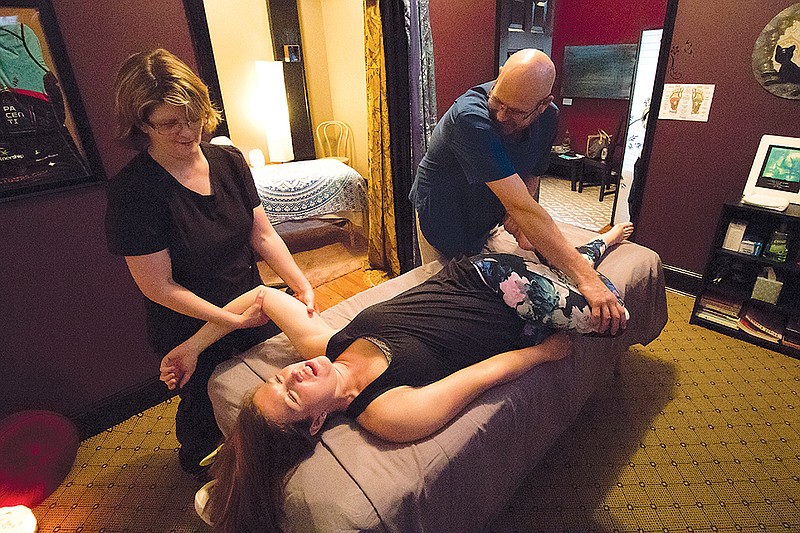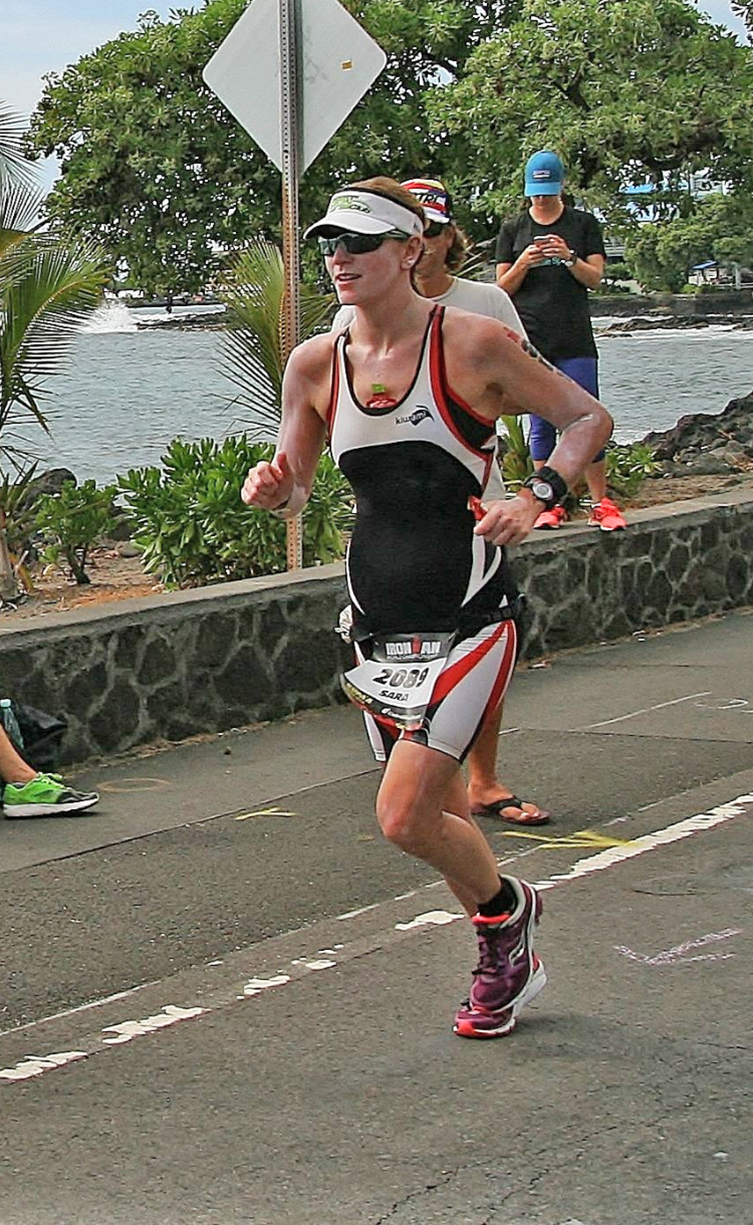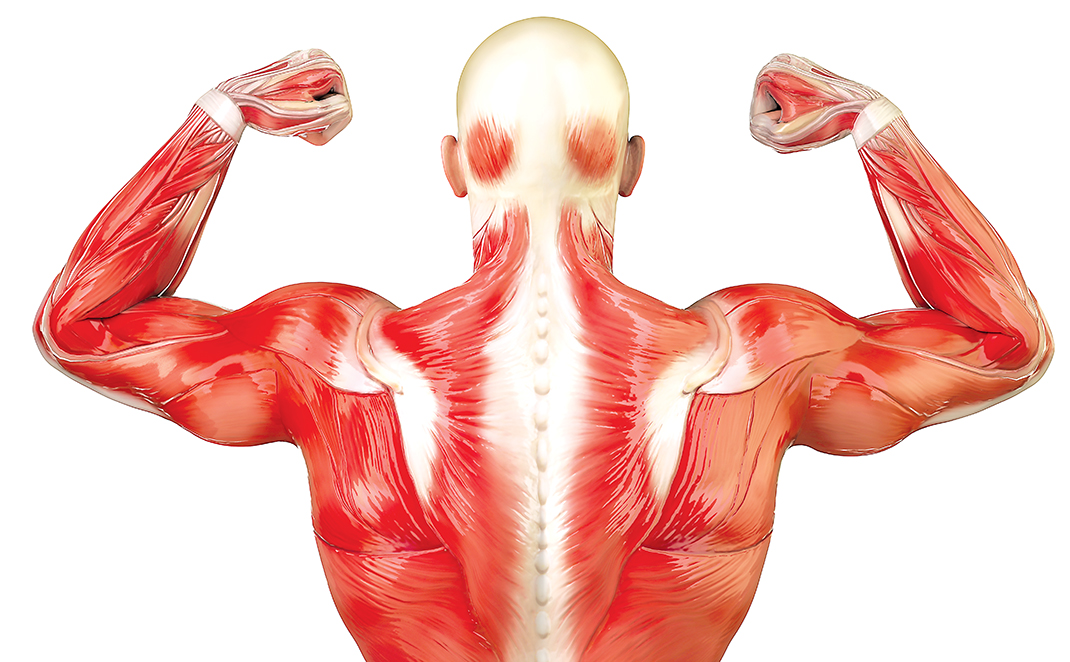"Uneventful."
But for 32-year-old Gibson, who had a history of IT-band flares so bad she could barely jog, "uneventful" was exactly what she wanted.
On race day, Gibson not only avoided pain, she placed first in the women's 30-34 age group, even shaving six minutes off her personal record for a time of 4:44:19 and qualifying for the Ironman 70.3 World Championship in Chattanooga this September.
Gibson says she owes that victory to ReVive Bodywork and Massage owner Virginia Lee, one of the many sports massage practitioners in the city enhancing the way local athletes prepare for competitive events.
A Deeper Look
While sports massage therapy has been steadily gaining popularity among casual athletes in recent years, it has long been considered an integral part of a well-rounded training regimen by a long list of professional athletes ranging from Olympic gold medalists to NBA stars.
Broadly defined, "sports massage" refers to the use of manual therapy techniques to achieve a specific goal while treating athletes - for example, treatment of IT-band issues using trigger point release.
Though the term "sports massage" serves as an umbrella for the trade's numerous facets, many fit into one of the two most common categories: pre-event massage and post-event massage. The first stimulates bloodflow to the muscles, helping to prepare them for the coming workout and to prevent serious injury. The second relaxes those overworked muscles, flushing out lactic acid and speeding up the recovery process.
Athletes have reported seeing improvements in flexibility, spikes in endurance and reduced levels of fatigue as a result of both their pre- and post-event sessions. But the greatest surprise, many of these athletes will tell you, is more often the sessions themselves.
While "massage" is part of the treatment's title, sports massage encompasses more than the hot rocks, warm towels and long, relaxing strokes characteristic of traditional Swedish-style treatments. Each therapist incorporates his or her own blend of techniques, such as stretching, acupressure or jostling, depending on the athlete's needs. Clients are often asked to perform stretches as the therapist works on them. Sometimes there are even tools involved, as Gibson discovered.
"It was new to me, but I was pretty open for anything that could help," the half-Ironman competitor remembers. Citing her initial discomfort with the tools, she adds, "I'll undergo temporary pain if it means that I won't be hurting during the race."
Gibson's open-mindedness was rewarded, of course, but not until after she was introduced to Myoskeletal Alignment Therapy, a unique treatment that can help a number of sports-related ailments.
Aligning with Benefits
When first-time clients walk into Mavis Davis' practice at Mitchell Robert Studio Salon, they might not always get what they want, but they'll definitely get what they need.
Those who enter in search of a relaxing massage to ease shoulder tension may, at first, be disappointed.
"Most people are skeptical," the licensed massage therapist says. "It's strange. This is not your typical massage session."
But it may be more productive, she adds. Instead of simply easing the shoulder pain until the next massage session, she's beginning a process that could, in time, provide more long-term relief.
That process is made possible by Myoskeletal Alignment Therapy, a technique created by Oklahoma bodywork teacher Erik Dalton - and one that is quite different from traditional massage practices. While many sports massage techniques focus on treating areas of the body that are stressed or overused from strenuous or repetitive movement, alignment therapy targets areas that are underused. Then, the therapy works to reactivate them, allowing those areas to bear some of the burden to relieve overworked muscles.
The method works through the manipulation of structural systems that promote alignment and balance throughout the body. For example, opposing muscle action.Each muscle in the body is physiologically paired with an opposite that serves as its antagonist, and every time the main muscle moves, its antagonist makes the opposite movement. That means that whenever one of these muscles is contracting, the other is relaxing, and vice versa. One such pairing is the pectoralis major muscles, which cover the upper chest, and the trapezius muscles, which cover the back of the neck and shoulders.
The human body was built to stand upright, but since no one has perfect posture all the time, our bodies eventually become accustomed to positions that are not ideal. That imbalance can lead to pain and injury, Davis says. Slouching, she says, is one of the most common examples. Sitting with shoulders rounded forward for extended periods of time keeps the pecs in a relaxed state at the expense of the continually stressed traps, and as the misaligned posture becomes more habitual, the body tries to adapt.
"The body is smart, and it's efficient," Davis explains. "So what the brain does is say, 'Oh! We spend a lot of time in this position. Instead of having to adjust every time, we'll just keep it this way.'"
Of course, that only makes matters worse. To accommodate the new posture, the brain stops sending blood and nutrients to the underutilized pecs, and over time, those neglected muscles become shortened and tight. With the chest muscles too tight to comfortably return to upright alignment, the traps are stretched forward, becoming weaker and causing shoulder pains to arise with time. This particular weakness tends to affect swimmers the most.
MORE THAN MASSAGE
If you're ready for the next level of race training, check out how alignment can up your game. Swimming: Shoulder injuries are the most common among swimmers, but good posture can keep the trapezius (shoulders and back of neck) and pectorals (front of chest) perfectly aligned and supporting the shoulder structure to help ward off that pain. Cycling: Trigger points in the vastus lateralis (side of thigh) can cause lateral knee pain that can feel very similar to and make a rider think there is pain in their IT band (outer thigh and knee). Activating the adductors (in the hip), however, can take pressure off the vastus lateralis, reducing the likelihood of that occurring. Running: Runners hoping for a leg up in any upcoming races can improve their stride length through proper alignment. Sitting stretches the hamstrings (back of thigh), causing the inactive quadriceps (front of thigh) to tighten. That tightness reduces range of motion when pushing the leg back on the track, but correcting the issue will allow for longer strides, and thus, better race performance.
Launching an assault on muscle strains caused by misalignment in the body is no easy feat.
Before they can even get started, practitioners like Davis and fellow alignment specialist Virginia Lee must first find the source of the pain. Sometimes that means looking at opposing muscle groups, but other times, it requires a more complex understanding of muscle alignment. Problems in the hip, for instance, can sometimes be traced back to a misaligned ankle that the knee is forced the compensate for, throwing the pelvic region out of balance, Davis says.
Once the root of the strain is found, the therapists get to work relaxing the location of the issue and activating the inert muscle using techniques like resistance stretching, a favorite of Lee's, to increase the muscle's range of motion and get it realigned little by little over time.
The goal of each session is to retrain both mind and body to recognize and adhere to its optimal position, Davis says.
But it isn't a goal they can accomplish themselves, Lee adds. Each athlete must be invested in his or her own treatment. The true test of commitment to recovery comes when the athlete is outside the massage studio's walls.
"I can activate a muscle on my table and get it moving the way it's supposed to, but another day or two after you leave, if you have not worked that muscle any more it's going to go back to the way it was before I got it engaged," Lee says.
Much like Davis, who leaves athletes with movement-based "homework" assignments to help their bodies acclimate to the new posture, Lee also gives assignments. Additionally, Lee draws clients' attention to muscle weaknesses they need to address, either with exercises or by talking to a physical therapist. Her hope is that they will seek whatever resource they need to break out of the pain cycle - just like her Ironman champ Sara Gibson.
Half-Ironman Schedule
Check out athletes at the top of their game when the half-Ironman returns to the Scenic City May 19-21. Friday 12-5:30 p.m. Ironkids Chattanooga Fun Run registration 12-7 p.m. Athlete check-in 12-7 p.m. Ironman Village 1, 3 and 5 p.m. Athlete briefing Saturday 7:30-8:30 a.m. Ironkids Chattanooga Fun Run registration 9 a.m. - 5 p.m. Athlete check-in 9 a.m. Ironkids Chattanooga Fun Run 9 a.m. - 5 p.m. Ironman Village 11 a.m., 1 and 3 p.m. Athlete briefing 1:30-5:30 p.m. Mandatory bike check-in 2 p.m. Pro Panel Sunday (Race Day) 4:30-6:45 a.m. Shuttle bus for athletes and spectators from transition to swim start 4:30-6:15 a.m. Transition opens for gear check-in & body marking 5 a.m. - 4 p.m. Information tent 6:50 a.m. Race start (1 mile upriver from Ross's Landing) 7 a.m. - 3 p.m. Ironman Village 7:30-8:30 a.m. Shuttle bus for spectators from swim start to transition (1 mile upriver from Ross's Landing) 1-5 p.m. Bike check-out 4 p.m. Awards ceremony & 2017 Ironman 70.3 World Championship slot allocation All events at Ross's Landing unless otherwise noted.
Spectator sport
Swim: Spectators will have a great opportunity to watch the swim from the Veterans and Market Street bridges and the Tennessee Riverwalk. Athletes will exit the water at Ross's Landing Park. Bike: Catch the end of the ride by posting up in historic Chickamauga, Ga.'s downtown area. Run: Two loops will take runners through downtown Chattanooga and the North Shore, across the Walnut Street and Veterans bridges and along the Tennessee Riverwalk and Riverfront Parkway before they finish at Ross's Landing.


